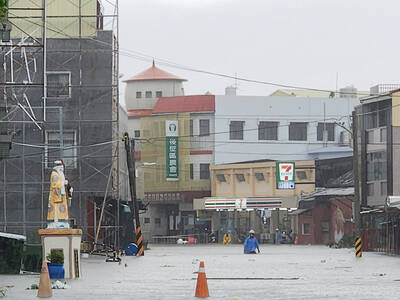Experts from Japan's Kobe University Research Center for Urban Safety and Security (RCUSS) yesterday recommended that the Taiwan government, which they said showed a lack of emergency planning and preparedness in handling the aftermath of the 921 earthquake, should review its response operations.
Among the measures to be taken, they said Taiwan needs to invest in an information infrastructure to support communication and coordination among levels of government involved in emergency response, said Louise Comfort, a visiting professor of public administration at RCUSS. She took part in a week-long inspection-tour to the disaster areas with a 15-member RCUSS team.
"Information regarding damage to affected areas was slow and incomplete in the first hours after the earthquake," Comfort said.
Loss of power, severed communications and blocked roads immediately after the quake were blamed for slow emergency response operations. The situation was similar to the 1995 Kobe earthquake that killed nearly 5,000 people, Comfort said.
Isao Kamae, another RCUSS professor, said a lack of information was partly responsible for the high casualties in Kobe, prompting the Japanese government to begin forming an information system for disaster and emergency response.
The emergency information network features the latest technology with multi-lines, multi-media, two-way communication and remote back-up, Kamae said.
Mobilization of personnel and equipment for emergency response demands a complex set of operations and coordinated actions by multiple agencies, governments, and private and non-profit organizations, the experts said.
The lack of heavy equipment and knowledge of advanced search and rescue techniques delayed rescue operations after last month's quake in Taiwan.
Comfort suggested Taiwan use resources at local universities to collect information on sites vulnerable to seismic and other hazards, as well as improve training of emergency response personnel.
In view of Taiwan's unique situation in the international community, Comfort said systems for humanitarian assistance should be established so that needed assistance will not be delayed or affected by political constraints.
Sun Chih-hong (
"No one imagined there would be an earthquake as severe as this one, so the budget, personnel and projects devoted were very limited," said Sun.
Sun said he believes the earthquake will help the program gain the financial resources needed and speed up the establishment of the disaster system in the government.
"The cost required for the system's establishment is far lower compared to the losses caused by the disaster," Sun said.
The program researches means of setting up well-equipped emergency operations centers and carries out surveys of earthquake-prone areas to work out possible disaster scenarios and strategies to deal with them.
Sun said models for disaster-prevention plans are expected to be completed for Taipei and Chiayi within two years.

Rainfall is expected to become more widespread and persistent across central and southern Taiwan over the next few days, with the effects of the weather patterns becoming most prominent between last night and tomorrow, the Central Weather Administration (CWA) said yesterday. Independent meteorologist Daniel Wu (吳德榮) said that based on the latest forecast models of the combination of a low-pressure system and southwesterly winds, rainfall and flooding are expected to continue in central and southern Taiwan from today to Sunday. The CWA also warned of flash floods, thunder and lightning, and strong gusts in these areas, as well as landslides and fallen

WAITING GAME: The US has so far only offered a ‘best rate tariff,’ which officials assume is about 15 percent, the same as Japan, a person familiar with the matter said Taiwan and the US have completed “technical consultations” regarding tariffs and a finalized rate is expected to be released soon, Executive Yuan spokeswoman Michelle Lee (李慧芝) told a news conference yesterday, as a 90-day pause on US President Donald Trump’s “reciprocal” tariffs is set to expire today. The two countries have reached a “certain degree of consensus” on issues such as tariffs, nontariff trade barriers, trade facilitation, supply chain resilience and economic security, Lee said. They also discussed opportunities for cooperation, investment and procurement, she said. A joint statement is still being negotiated and would be released once the US government has made

SOUTH CHINA SEA? The Philippine president spoke of adding more classrooms and power plants, while skipping tensions with China over disputed areas Philippine President Ferdinand Marcos Jr yesterday blasted “useless and crumbling” flood control projects in a state of the nation address that focused on domestic issues after a months-long feud with his vice president. Addressing a joint session of congress after days of rain that left at least 31 dead, Marcos repeated his recent warning that the nation faced a climate change-driven “new normal,” while pledging to investigate publicly funded projects that had failed. “Let’s not pretend, the people know that these projects can breed corruption. Kickbacks ... for the boys,” he said, citing houses that were “swept away” by the floods. “Someone has

‘CRUDE’: The potential countermeasure is in response to South Africa renaming Taiwan’s representative offices and the insistence that it move out of Pretoria Taiwan is considering banning exports of semiconductors to South Africa after the latter unilaterally downgraded and changed the names of Taiwan’s two representative offices, the Ministry of Foreign Affairs (MOFA) said yesterday. On Monday last week, the South African Department of International Relations and Cooperation unilaterally released a statement saying that, as of April 1, the Taipei Liaison Offices in Pretoria and Cape Town had been renamed the “Taipei Commercial Office in Johannesburg” and the “Taipei Commercial Office in Cape Town.” Citing UN General Assembly Resolution 2758, it said that South Africa “recognizes the People’s Republic of China (PRC) as the sole